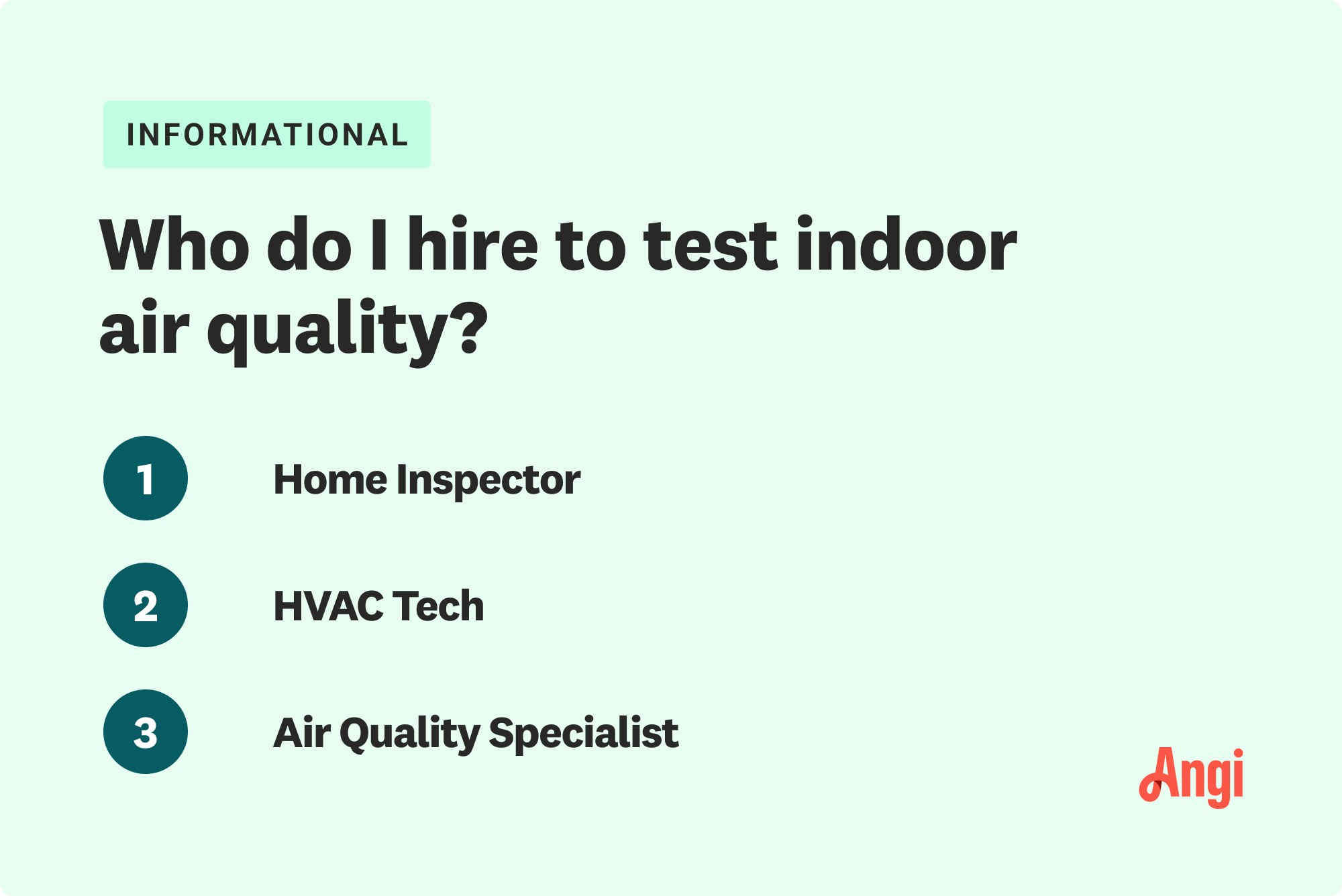How Much Does an Indoor Air Quality Test Cost? [2024 Data]
Normal range: $290 - $582
A professional indoor air quality test costs between $290 to $582, depending on home size.


Testing the air quality in your home will cost between $290 and $582, on average. It’s largely dependent on location or which type of test is required, with some tests costing as low as $150 or, for more complicated testing, as much as $1,045. The issue with air testing is that as a homeowner, you might not know exactly which test you need, so budgeting for the professional who can help you decide can be pricey, but consider it an investment in ensuring safe air in your home.
- Average
- $436
- Low end
- $150
- high end
- $1,045
Indoor Air Quality Testing Cost Factors
These tests range in price depending on the size of your home, what pollutants you are testing for, and whether you are testing before purchasing a newly built property.
Generally speaking, the average air quality test costs around $420, with a low-end price of $150 and a high-end price of $1,000. The median range is $280 to $560.
Here is what impacts the cost of indoor air quality tests.
Home Size
By far the largest price variable with these tests is the size of the home. Obviously, larger homes cost more than smaller properties. Inspectors take samples of the air to root out potential health dangers, so they’ll likely need samples from each designated space in your home. Here are common home sizes and their associated cost breakdowns.
| Size | Cost |
|---|---|
| Less than 1,000 square feet | $200 – $300 |
| 1,000 to 2,500 square feet | $300 – $500 |
| Over 2,500 square feet | $500 – $1,000 |
| Commercial size | $1,000 – $3,000+ |
Pollutants
| Testing Type | Cost |
|---|---|
| Mold Testing | $300 – $1,000 |
| Allergen Testing | $100 – $200 |
| Asbestos Testing | $200 – $800 |
| VOC Testing | $200 – $300 per request |
| Radon Inspection | $150 – $800 |
| Carbon Monoxide Detection | $100 – $200 |
A basic whole-home air quality test costs an average of $420. It helps identify the presence of mold, volatile organic compounds (VOCs), various common allergens, pet dander, and carbon monoxide.
However, many homeowners benefit from highly specific tests for particular pollutants that offer a more in-depth analysis than the basic package. These stepped-up tests vary in price depending on the type of pollutant.
Mold Testing
A basic home package identifies the presence of mold. Still, it may not identify the type of mold or its exact location in the home. For a thorough mold-related air quality test, you’ll pay $300 to $1,000, with an average cost of $700. Once you are properly informed, contact a local professional mold remediation company to discuss removal options.
Allergen testing
Again, a basic indoor air quality test identifies some common allergens, but those with specific sensitivities may opt for a more detailed examination. Testing for specific allergens costs $100 to $200 but susses out pest particulates, pest waste, pollen, dust mites, and more.
Asbestos Testing
Asbestos is a nasty and dangerous fiber previously used in building materials. If you have an older home and suspect the presence of asbestos, an asbestos air testing package costs $200 to $800, with an average price of $500. As an aside, asbestos removal costs between $1,120 and $2,910.
VOC Testing
You can test for specific volatile organic compounds, such as formaldehyde, for $200 to $300 per request. Many common household items include VOCs, such as paint, household cleaners, hairspray, cigarettes, and even burning candles.
Radon Inspection
Radon is not overly common with modern homes, but when found it represents a particular health danger. A comprehensive radon-specific air quality test costs $150 to $800, depending on the size of the home.
Carbon Monoxide
Detection services for carbon monoxide range from $100 to $200. Many homeowners have carbon monoxide detectors in their houses to perform this service. Carbon monoxide detectors cost $15 to $150, depending on the style.
New Builds and Home Purchases
Before moving into a newly built or purchased home, consumers often spring for a comprehensive air quality test that analyzes contaminants commonly released by construction materials. These specific tests range from $200 to $1,000, depending on the size of the home and the complexity of the design.
What Causes Bad Indoor Air Quality?
Indoor air quality can quickly degrade when certain events happen. Take for example a forest fire: without proper sealing of windows and doors, indoor air will quickly become contaminated with the same airborne particles. Other common causes of a decrease in indoor air quality are:
Inadequate ventilation.
Mold and mildew present in the house, in the walls, or under the floor.
Indoor pollutants like dust, pollen, smoke, asbestos, paint, and others.
Pest droppings or even the bodies of animals in the walls or ventilation system.
Disintegration of HVAC air filters (check regularly).
Building materials that haven’t been properly ventilated.
The human body has become conditioned over time to withstand a great deal of abuse. The problem with bad indoor air quality is that by the time you notice it, it’s usually well beyond a level considered safe. If you notice anything strange, either a smell or your respiratory system acting up, and the air outside is clean, throw open the windows, and call a professional.
Signs You Need an Air Quality Test
You should get an air quality test when you can tell the quality has dropped, but what about when it isn’t so apparent? Consider an air quality test at least once a year, or when anything changes in the house, such as:
Any new or unexplained health symptoms.
Any persistent or widespread mold or mildew.
Any significant water damage.
Any new construction or renovation.
The purchase of a new home or moving into a rental.
New HVAC install.
A good rule is to get an air test when anything major happens in the home. This could be damage, restoration work, or maybe the new thing is the home itself. Seriously consider an air test when moving into a new property in order to verify the air is safe—you don’t know everything that happened in that house, unless it’s brand new.
Who Do You Hire to Perform an Air Quality Test?

You can’t just buy an air quality test kit, run the results, and call it a day. An air quality test needs to be performed by a professional. A home inspector or HVAC professional are two of the more commonly hired testers, but there are others who may be more appropriate, depending on where the air you’re testing is located.
A Certified Industrial Hygienist (CIH) is someone who has been board-certified to protect the health and safety of both workers and the general public. These professionals are usually seen in more industrial settings, such as commercial properties, and they will be the most expensive, but usually possess the highest level of competency.
Air quality specialists are usually referred to as Indoor Air Quality (IAQ) techs. IAQ techs perform a similar function to CIHs, but they aren’t certified in the same way, and may not be able to provide the same level of detail. However, IAQs are professionals who are more than capable of testing the air in your home.
Using a DIY Air Quality Test Kit vs. Hiring a Pro
There are many at-home air testing kits out there, costing anywhere from $15 to $200, depending on the type of pollutant tested and the size of your home. These kits save some money when compared to hiring a professional, but you’ll still need an expert to verify the results if any of them come up positive. Additionally, at-home tests cannot actually diagnose problems and recommend a course of action.
One of the reasons to hire a pro, especially a local mold inspection professional, is that they have access to more powerful testing tools than can be bought at a home improvement store and they are trained to make homes safe in ways that the average person might not even think of. For certain projects, like replacing a door or putting up drywall, you can absolutely DIY it, but air testing—really anything involving your health—should be done by a professional.
How Angi Gets Its Cost Data
Home is the most important place on earth, which is why Angi has helped more than 150 million homeowners transform their houses into homes they adore. To help homeowners with their next project, Angi provides readers with the most accurate cost data and upholds strict editorial standards. We’ve surveyed thousands of real Angi customers about their project costs to develop the pricing data you see, so you can make the best decisions for you and your home. We pair this data with research from reputable sources, including the U.S. Bureau of Labor Statistics, academic journals, market studies, and interviews with industry experts—all to ensure our prices reflect real-world projects.
Want to help us improve our cost data? Send us a recent project quote to [email protected]. Quotes and personal information will not be shared publicly.
Frequently Asked Questions
A professional indoor air quality inspection takes anywhere from one to three hours, depending on the size of your home and the number of necessary samples. After the test, the specialist will discuss the findings, but you won’t get a full written report for 2 to 10 days, though you can ask your pro to expedite the process, if needed.
In some cases, a home inspector tests the indoor air quality if properly certified. Most of the time, however, they’ll outsource the work to a professional air quality consultant. Testing indoor air for pollutants requires several certifications and a suite of specialized tools. Many HVAC and home inspection pros have this certification.
A DIY kit can lessen the sting that comes with paying for a professional assessment, but these comprehensive tests are true lifesavers. Inspectors are more likely to catch all of the pollutants and hazards in your air. Plus, you’ll still need a professional to verify and act on your DIY test results.
Some kits don’t include tests for certain air pollutants or only detect their presence, but not their levels (i.e., mold spores). If you’re willing to shell out money for a DIY kit, it’s usually better to stretch your budget slightly higher for a more detailed assessment.
